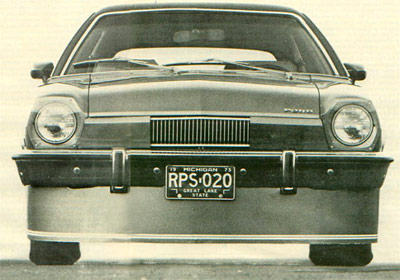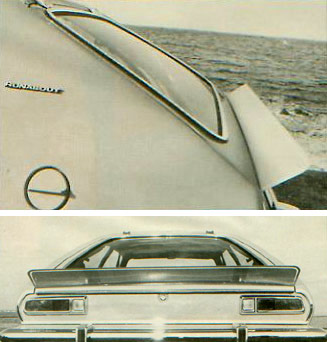
34 years ago this month in March, 1974, Car and Driver magazine ran a feature article about DIY modifications that improve fuel economy. The article was a response to the 1973/74 oil crisis – the first time people started seriously talking about improving fuel efficiency as a way to address energy security and high gas prices.
But the magazine did a lot more than just talk about efficiency. They grabbed the bull by the horns (okay, a Ford Pinto by the bumper) and actually did something about it. The article, called Project Car: Crisis-Fighter Pinto, documented six relatively simple modifications which actually saved gas. And most of them would benefit new cars today.
After the jump: the six modifications in detail.
The Car & Driver guys didn’t touch the Pinto’s engine. Instead, they reduced the amount of work the engine had to do. Fuel is burned to overcome two predominant forces: rolling resistance and aerodynamic drag. At highway speeds, aero drag dominates, and that’s where Car and Driver spent most of its effort – and the $11 for supplies.
Mod #1: Front air dam.
They started by making & installing an air dam beneath the Pinto’s front bumper to divert as much air flow as possible away from the car’s aerodynamically dirty underside. That single change accounted for fully one quarter of their gains.
 Mod #2: Partial grill block.
Mod #2: Partial grill block.
Another highly turbulent air pathway is the cooling system. Most cars’ grill openings are sized to keep the engine cool in absolute worst-case conditions (think Death Valley, pulling a trailer). By blocking part of the Pinto’s grill, they were able to improve efficiency without adversely affecting engine temperatures in normal driving.
Mod #3: Smoother tail (rear spoiler).
The aerodynamically ideal shape at the rear of a vehicle is a gradual taper that helps minimize the size of the turbulent wake left behind. But the slope of the Pinto’s rear window was too steep. By adding a six inch spoiler, they effectively changed the angle of air flow between the end of the roof and the back of the car. The result: a 7% MPG improvement.
Mod #4: Smoother nose.
While almost every new car sold today has a smoothly contoured front end, the Pinto’s face left a lot to be desired. To partly address this, they made and installed convex plexiglass covers over the car’s headlight buckets. That small change added 0.1 MPG.
Mod #5: Reduced parasitic loads.
Back in ’74, most cars sported a belt-driven radiator fan. By removing two of the Pinto’s four fan blades, it was made more efficient. Today, most vehicles have electric cooling fans that run on demand only.
Mod #6: Reduced rolling resistance.
The stock Pinto came with bias-ply tires. Switching to steel belted radials netted a 5% MPG improvement. While all new cars today come with radial tires, LRR (Low Rolling Resistance) versions are available which offer an equivalent improvement over “standard” radials.
 Car & Driver demonstrated that even with a so-called “economy” vehicle, the auto maker had left a lot on the table in terms of potential efficiency gains.
Car & Driver demonstrated that even with a so-called “economy” vehicle, the auto maker had left a lot on the table in terms of potential efficiency gains.
What’s more, they concluded, “they are all the type of changes you can make – without going broke – and the type of change the car makers will have to make for the coming model years. Bluntly, this is the way it will be.”
Unfortunately, this isn’t the way it turned out. Particularly when it comes to fuel-wasting, poor aerodynamics, the auto makers still have a lot of room to improve.
Resources:
- Discuss this post: “Car and Driver magazine ecomods a car: MPG up +25%”
- Aerodynamics forum – Ecomodder.com
.
Popularity: 15% [?]




{ 23 comments }
This is cool, but I wonder how relevant it is today. Tires have gotten better and less “roll-resistant” and I’m sure cars have gotten much more aerodynamic.
…uh wasn’t that the car that exploded on impact?…just sayin!
It’s not 100% relevant (the fan part doesn’t apply at all to today’s cars), but the equivalent of going from bias ply to radial today would be: going from regular radials to LRR radials.
There are still lots of potential gains to be made aerodynamically in modern cars, and that’s where Car & Driver found the largest gains.
WOW! 15mpg highway in stock configuration. That’s pathetic- even our “Gas Guzzlers” today do better. Malaise era Pinto indeed.
Electric fans are a step in the right direction for sure, but why not an alternator that disconnects itself physically when not needed. Alternators are made to be able to recharge the battery quickly even though this is not usually necessary. Lots of over kill. How about a peltier device (thermocouple) to generate some of the electricity needed from all the waste heat that a gasoline engine creates.
Same with water pumps. Lots of churning the coolant even when very little coolant recirculation is needed.
Oh, one other thing…. if people were a little bit lighter the car would not have near so much work to do! LOTS of room for improvement in that arena. 😉
Wow, 15 miles to gallon with either a 2.0 or 2.3 liter engine was the start? And it got to just over 18 after they were done? I have to say that things have improved a bit already don’t you think? 2.4 liter Honda Element – 24.5 mpg, and it is a brick of a car for aero.
And yes, it did explode, we used to call it the Flinto -all you needed to do was strike it to get a flame. 🙂
Amazing what a little wrenching can accomplish on any ordinary car. Nice post Darin!
The easy gains have already been made since the 70s. Notice they only got this compact car up to 18mpg highway with all their mods. By tinkering with the aerodynamics you are likely to make things worse on today’s cars, not better… unless you have access to a wind tunnel.
They also destroyed the cooling capacity of the car by blocking off the grill and removing blades from the fan… how many gallons of gas can you buy for the engine damage that can result from overheating?
Thanks for the comment, bob, unfortunately I’m going to have to disagree with you.
If one has any concept of aerodynamics, it’s not hard to make improvements over today’s vehicles. In fact, while some of them are better than they were in the past, there has been little across the board aerodynamic improvement in a while.
People who block their grill or change their radiator fan are very conscious of the way it affects engine heat. I’ve never heard of an engine overheating, and even if it began to, it’s as simple as removing the grill block. Truckers and bus drivers do it, Honda even designed a factory grill block you could add to you car for just that purpose. I would say it’s fairly safe.
Thanks again.
This was a carbureated car but also may have had higher octane fuel. My dad had a 67 400 ci pontiac and pulled a small travel trailer and got 15 mpg in 71. 76 500ci caddys got pretty good mileage also. I had a new 8900 gvw 76 3/4 ton 4wd chevy silverado with the 300hp chev 327 cam and 600 holley that got 15 mpg with 4:10 gears and 16.5 tires. My company NCR went from 72 torino station wagons to the pinto station wagons (automatic) and they were real slugs but the little 2.3 ended up being a pretty good motor.
Charlie
Thanks for the post
With most cars that have an automatic transmission the radiator also cools the the transmission fluid and there is no temp gauge for or idiot light for that. There is a channel at the bottom of the radiator for the transmission fluid. I’ve had to install separate small radiators and fans in cars when I lived in CA after I had to buy a rebuilt transmission to prevent another costly repair.
The improved MPG was for a Pinto going 70 MPH. This does not give the average MPG for a pinto which I believe was closer to 25 -30 MPG.
Yes, over heating could still be a problem if you live in an area where the average temperature is higher than average. Grill blocks are best in areas with temperate climates. An adjustable Grill Block sounds good to me. May be even make one that adjusts automatically.
Most replacement tires are not LRR. You have to shop around for those. Do some research on what tire models are currently the best. Do not count on tire sales people to know this.
Best car I ever owned:
1972 1/2 Pinto Wagon. Used It only for commute purposes only, 5 days per week, 100 miles a day. Changed oil ever other Month, never used oil between changes. Drove 70 miles an hour to and from work. M.P.G. was 24, and tires were replaced every 70,000 miles. Never replaced the engine, the car had two paint jobs due to rock chips and blue paint fad. Always outside, never wrecked, or abused, a real cherry, but a lot of miles, 317 thousand, and was still running great when I sold It in, 1989. Bought an El Camino, 1985, and I am still driving It today, and It’s also a cherry. If they were to build a new pinto today, just like the old one back In 1972, I would buy one. Yes, I would also keep my beautiful 85 El Camino. What do you think?
I very much love summer 🙂
Someone very much loves winter 🙁
I Wish to know whom more 🙂
For what you love winter?
For what you love summer? Let’s argue 🙂
oh ford sux any way you paint it, their emmisions have always been the worst in the industry and their one electric car, they desided to shaft the leasers with reposessions, they made the car just to shut the hippies up and then they pulled the plug just like GM did to their electric vehicle, the american manufacturers make way to much money in consesions from the petroleum industry to make cars that are less efficient today than they where years ago, , my VW jetta 96 gets an incredible amount of miles, an i am still not satisfied, even though it is a gem to drive, the fact that with only 2 valves per piston, it still needs to be a 2.0litre car and only gets around 30 miles is deplorable, when my girlfriend’s 1.7litre Honda has 4 valves per piston and gets better mileage than i can, with less hardware and moving parts to load against the force generated from combustion.
Of course ford hasn’t one car that can boast of getting better millage than mine or hers with half the creature comforts, still, it angers me that even though Porche invented the in wheel electric motor concept around WW2 with batteries, the gas car got taken more seriously than the car that did not cost nearly as much to maintain and constantly feed an even older concept, is the PRENDEV magnet motor to couple to a generator or alternator to generate the needed electricity using physics, the whole greasy petroleum addiction problem could have been averted and aerodynamics would not be an issue in design other than to economize on drag.
Wow, I didn’t remember my first car, a red Pinto, got that poor gas mileage. But then, I was paying 35 cents a gallon in 1971 – 10 cents per gal. more than the least expensive gas because I thought there was something was wrong with it!!! LOL
Wow, I didn’t remember my first car, a 1971 Pinto, got that poor gas mileage. But then, I was paying 35 cents a gallon back then – 10 cents per gal. more than the least expensive gas because I thought there was something was wrong with it!!! LOL
Radial tires can be crossed in the rotation pattern from side to side. Bias ply tires have a front to back pattern. I got this information from a very dedicated tire and wheel company when I bought my tires online.
for the person who suggest that alternators slow down engines based on their maximum capacity:
Alternator’s resistance is not fixed. The physical resistance comes from the force needed to rotate the coil in magnetic field created by another coil (which creates electricity). The resistance and the charging is controlled by varying the current in the “other” coil. so in short alternator’s braking effect is adjusted based on the need.
Thus turning fan off, having lights off or low consumption LEDs will infact affect gas mileage.
Between 1976 – 1989 I owned eight Ford Pinto. They were one of the most maligned jem’s in the automobile world. My first one produced a rock solid 25 MPG at 60-65 MPH before I began modding it. I never got over 27 MPG at 70 mph, but it could keep of with most of the V-8 pony cars of the day.
The car and driver article was helpful, and gave me clues for the direction to take my modifications. Aerodynamically, the rear spoiler made the biggest difference. The airdam had a positive influence, but only if it did not extend below the front suspension crossmember. Blocking the grill made almost no difference, but did over heat the engine, especially modified engines (Ford built their cars with radiators on the small side, this increased mpg by running the engine hotter.)
The Ford engineers obviously designed the Pinto for comfortable ergonomics, not aero-efficiency, (compare it’s shape to a Prius and it becomes obvious they are aero opposites.) Plus, the frontal area of the Pinto limited it to 105 mph with engines of less than 150 hp. Extra horsepower made them quick, not fast.
At the time I did my investigations I was actively racing autocross on the weekends in Denver, CO. I built a total of seven modified engines, cumulating in a fully balanced, alignment bored, ported head engine with headers and weber carburetion. That Pinto pulled away from a Pontiac Firebird at 80 mph, but delivered a consistent 25 mpg in my commuting. Back then the guys I hung with called our car’s “mini cars,” today they would be called “Tuner’s.”
But, no matter what you call them, there is plenty of leeway for improving light weight, mass production automobiles.
i drive a pinto every day 2/11/11 my 78 pinto crusin wagon pannel
i put a turbo 2.3 in it with a 3.18 rear gear and i get 40 mpg so dont tell me a 2.3 dont get mph evan befor i put efi in it i got 28 mpg
Comments on this entry are closed.
{ 9 trackbacks }